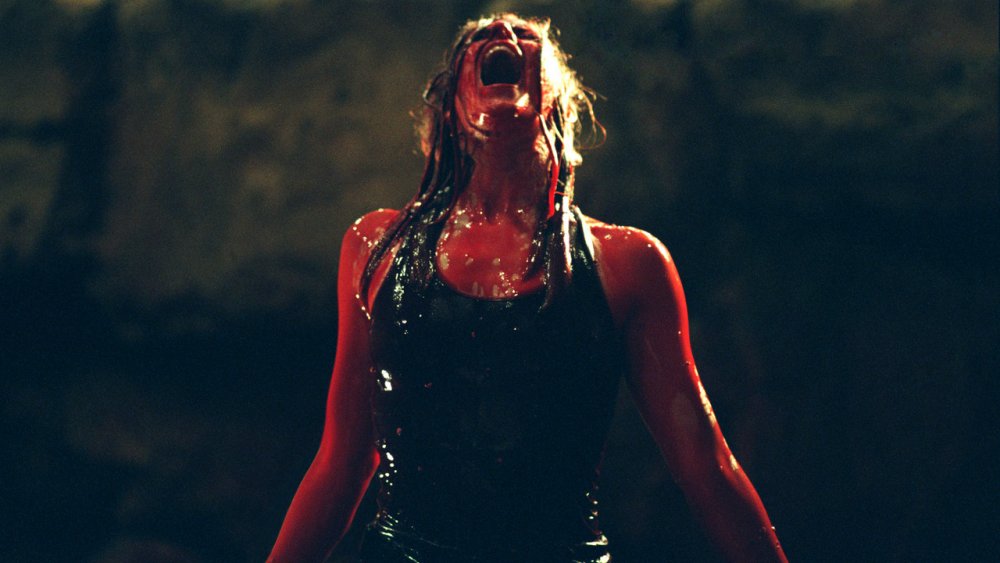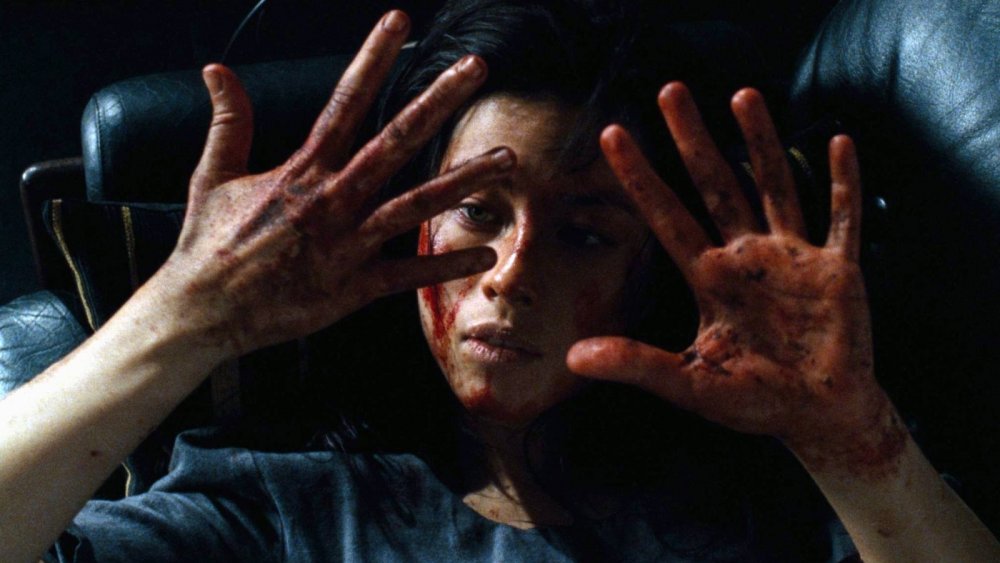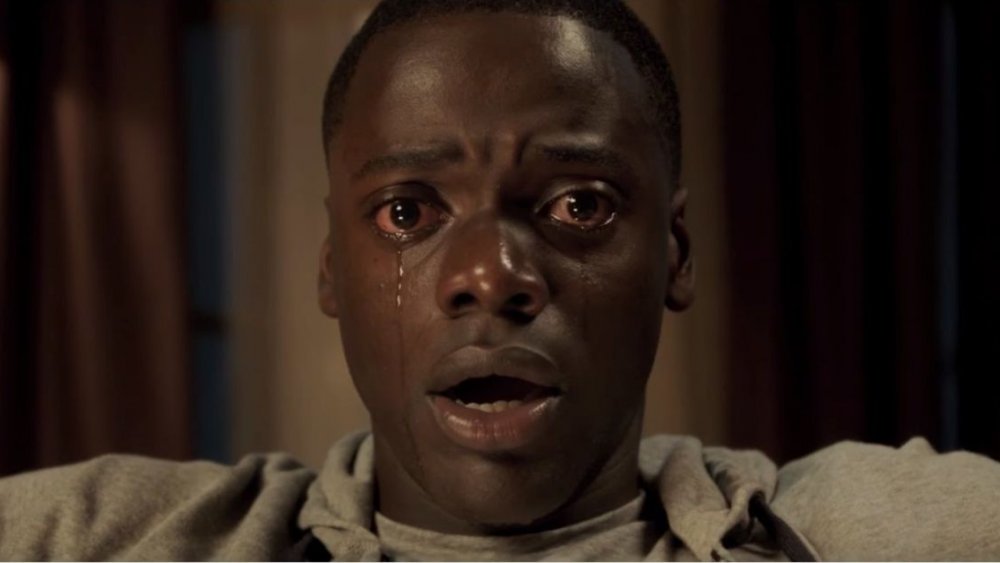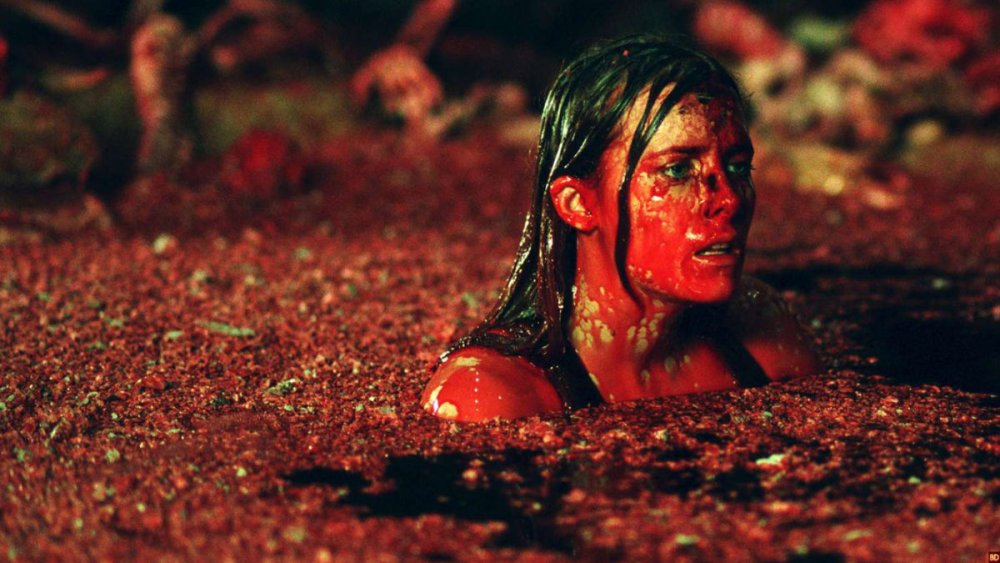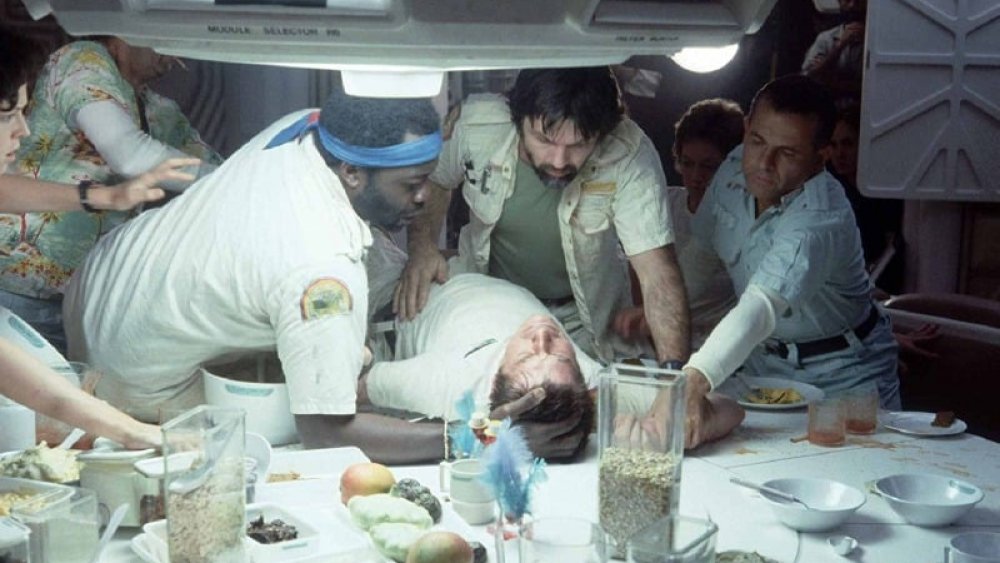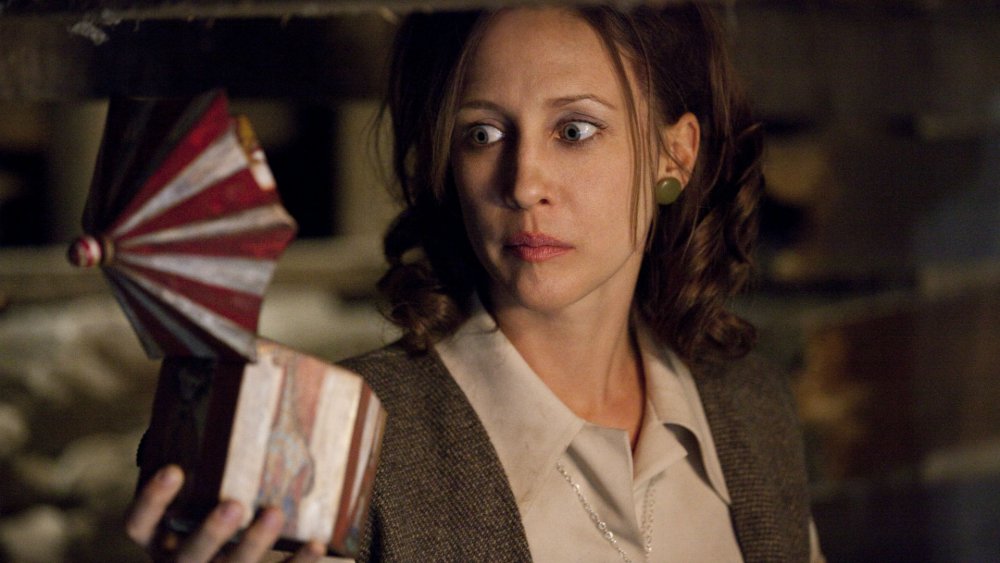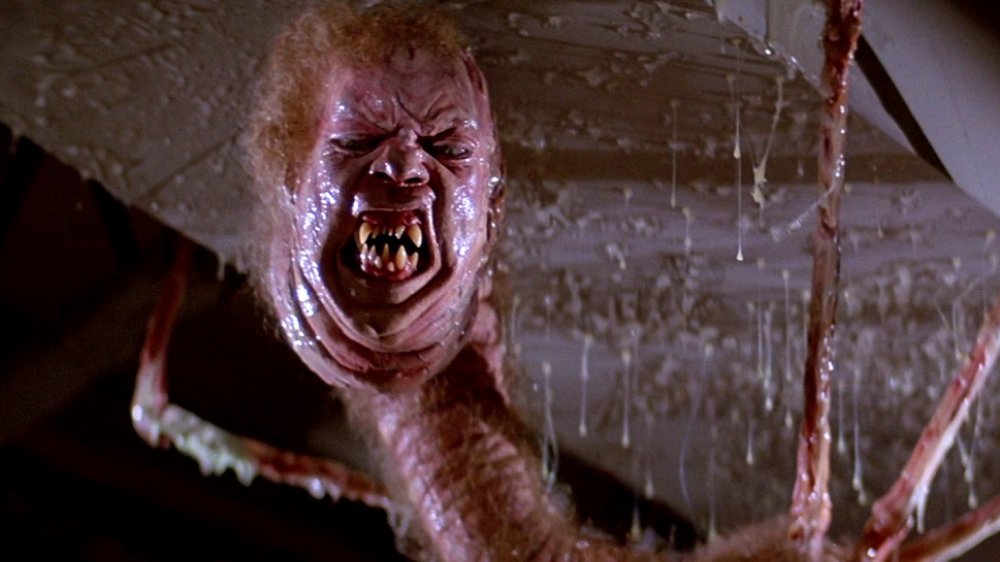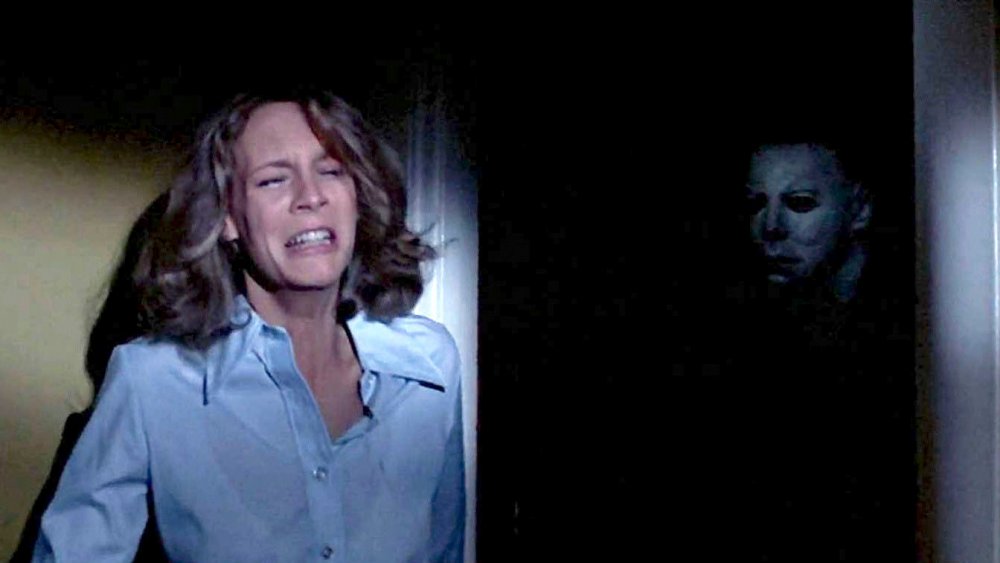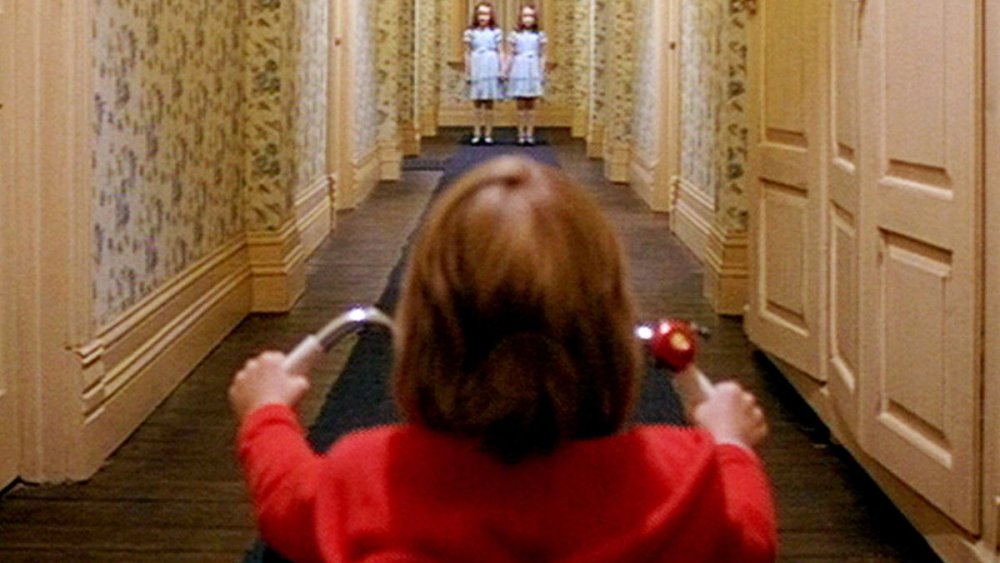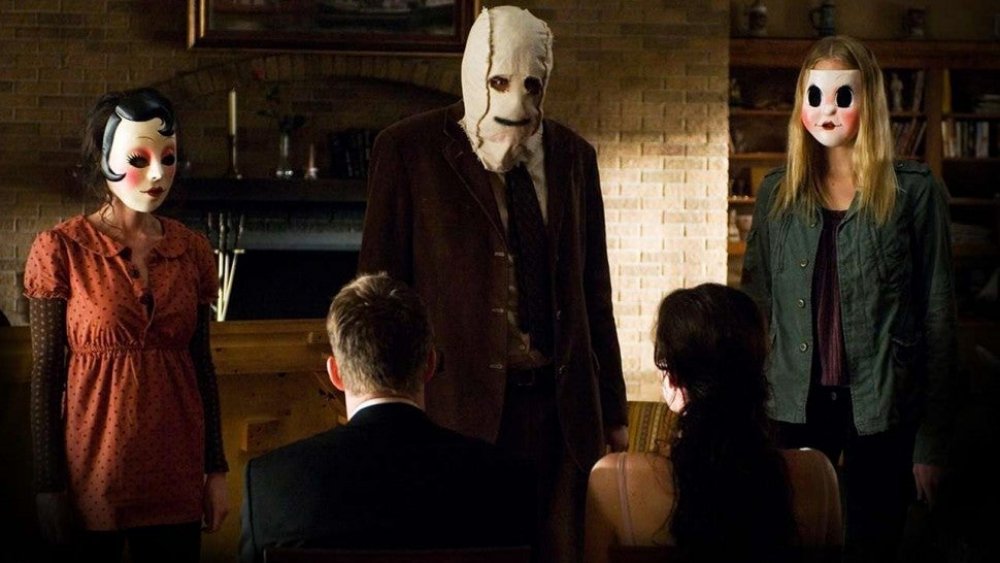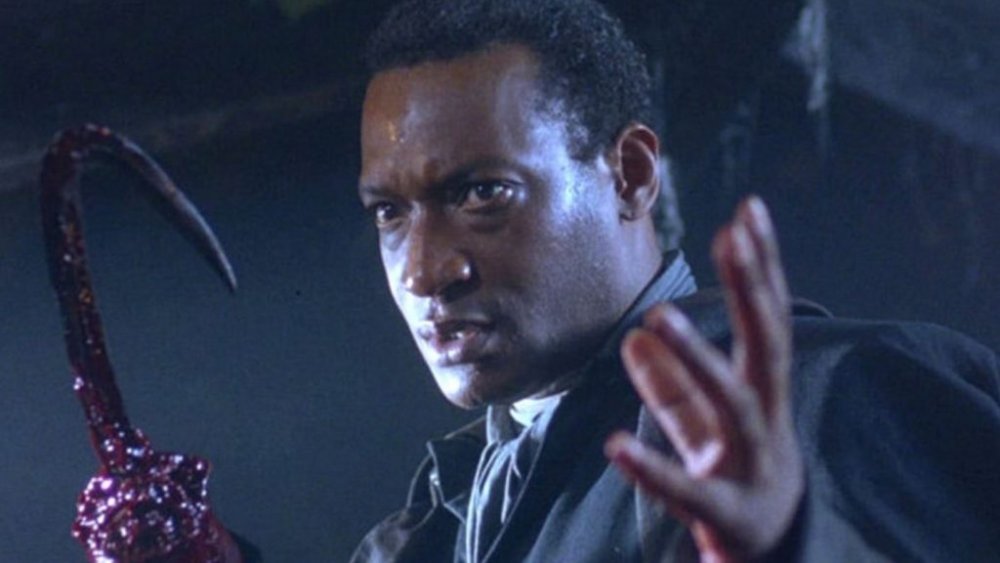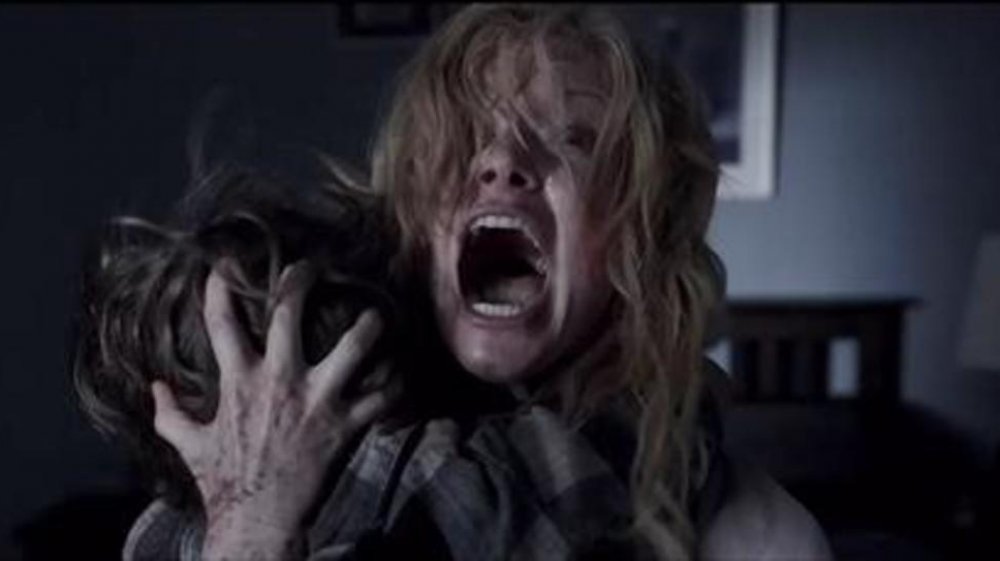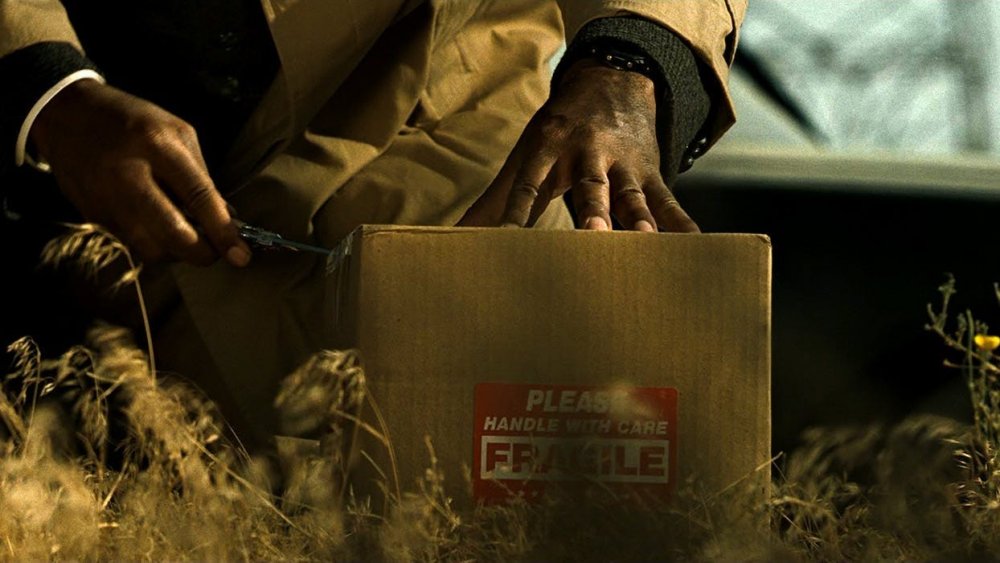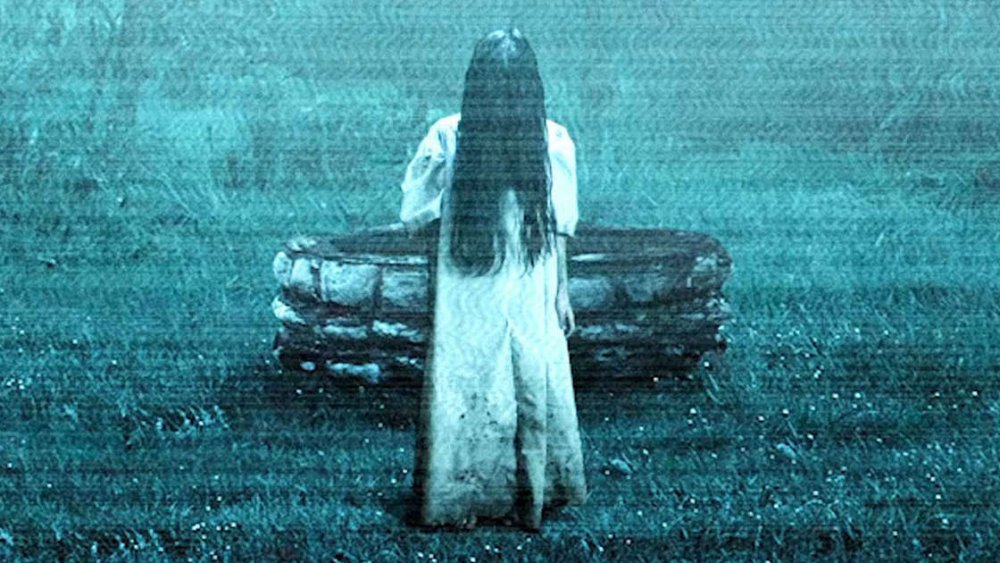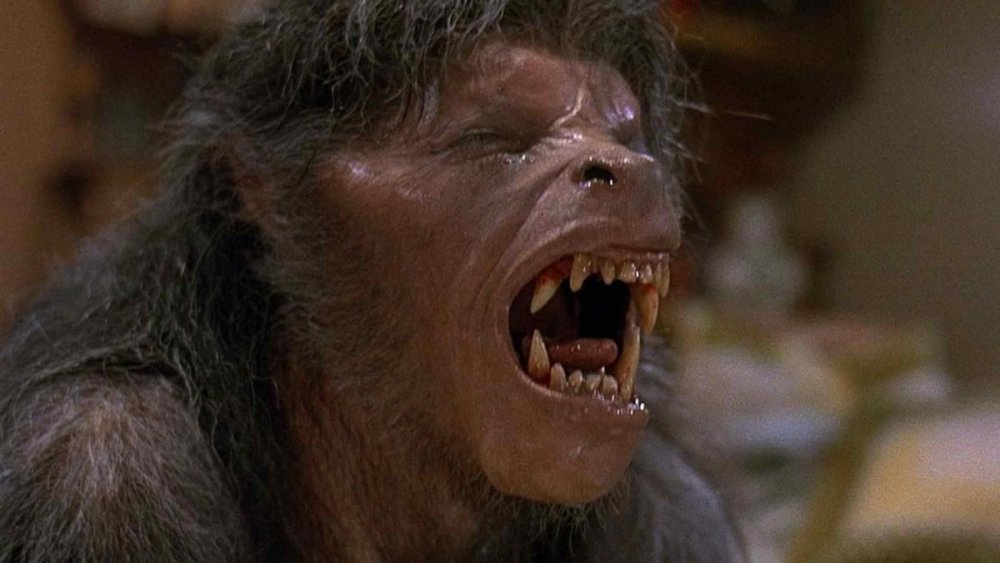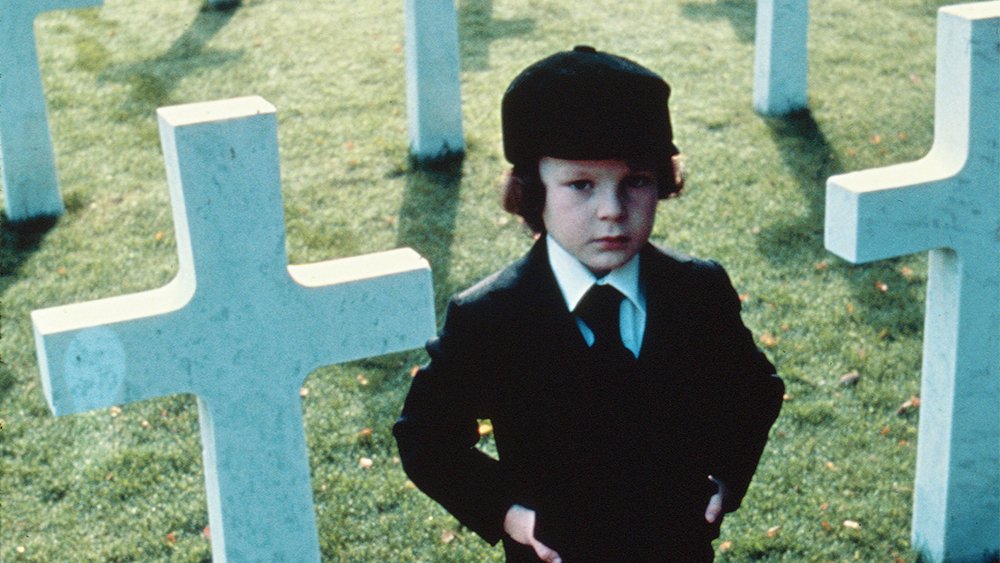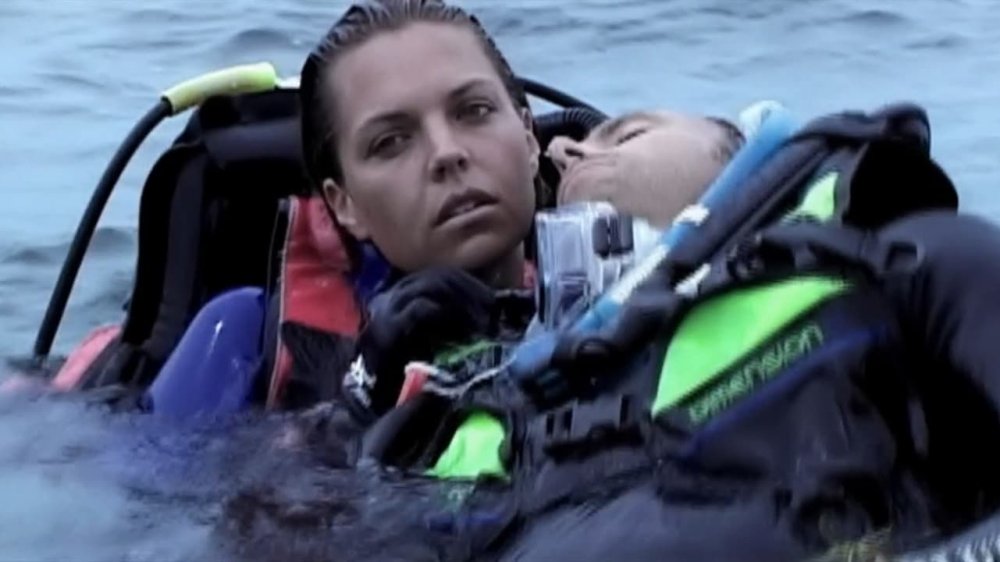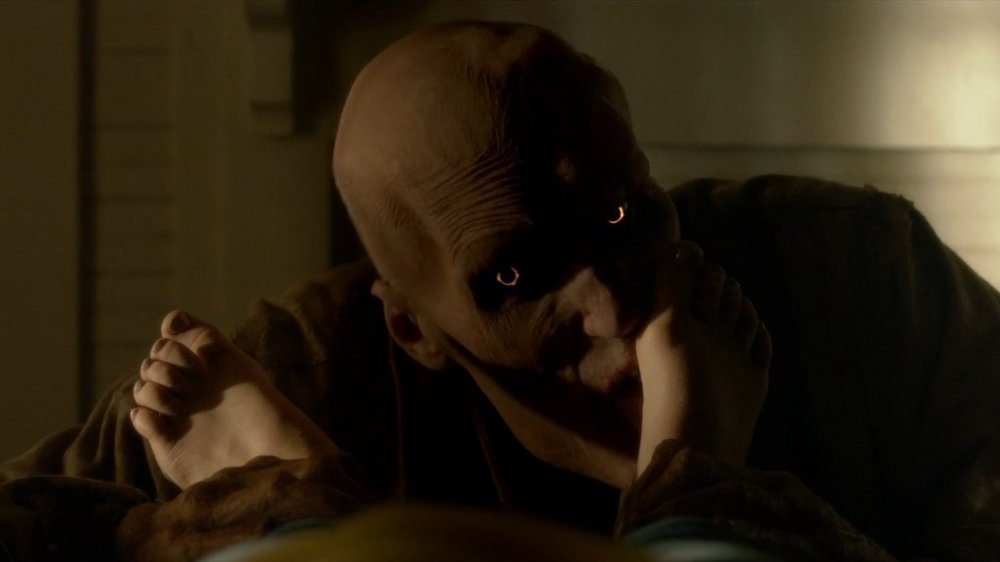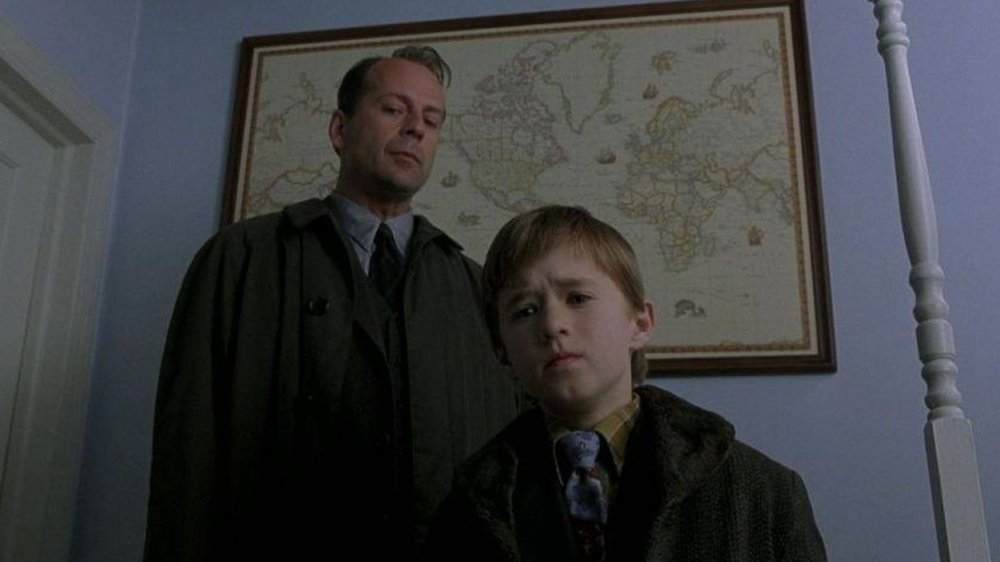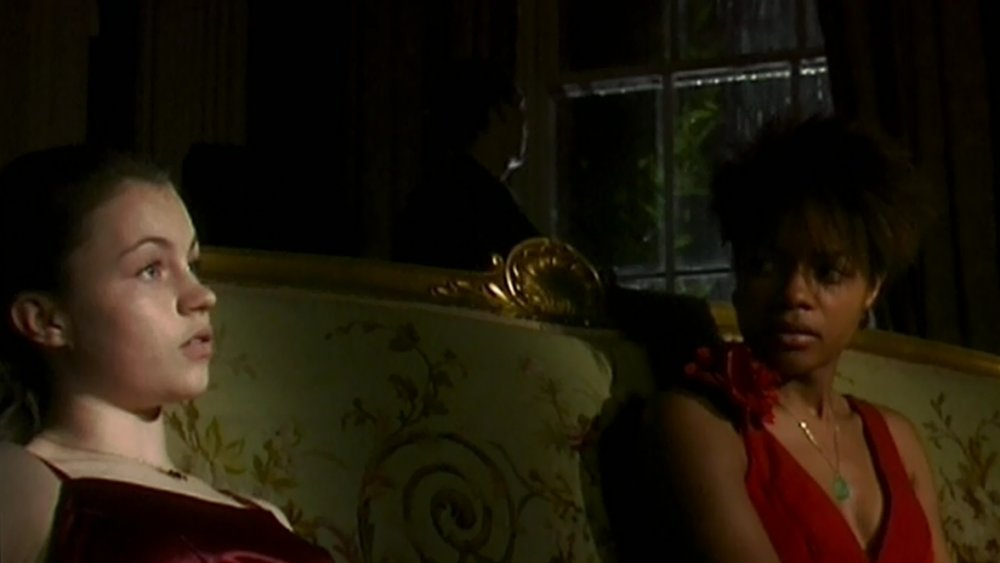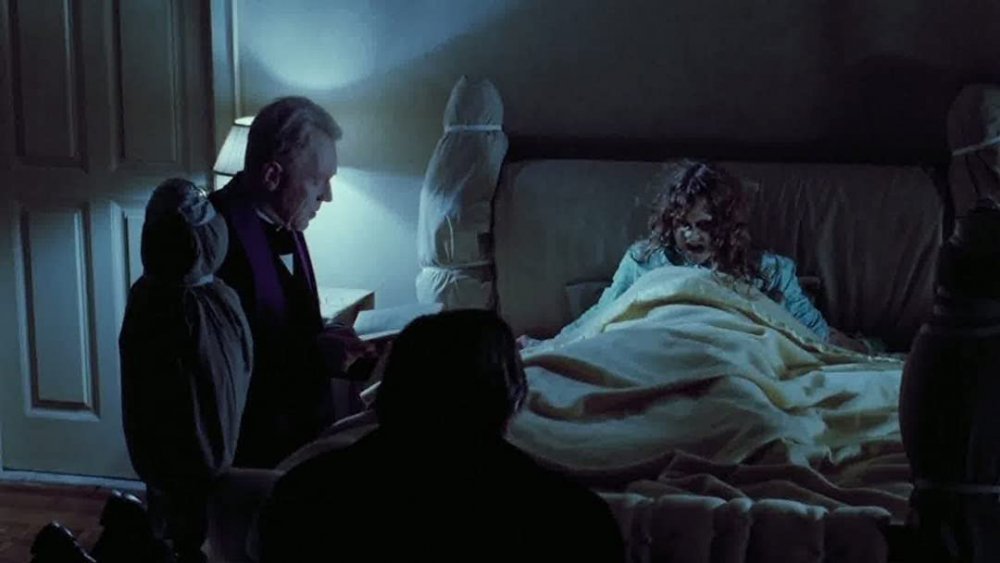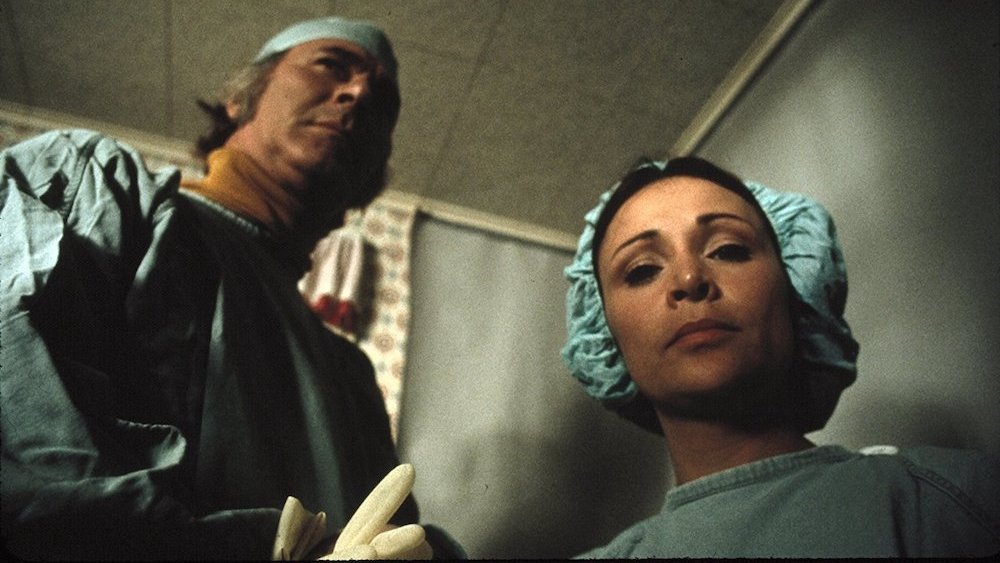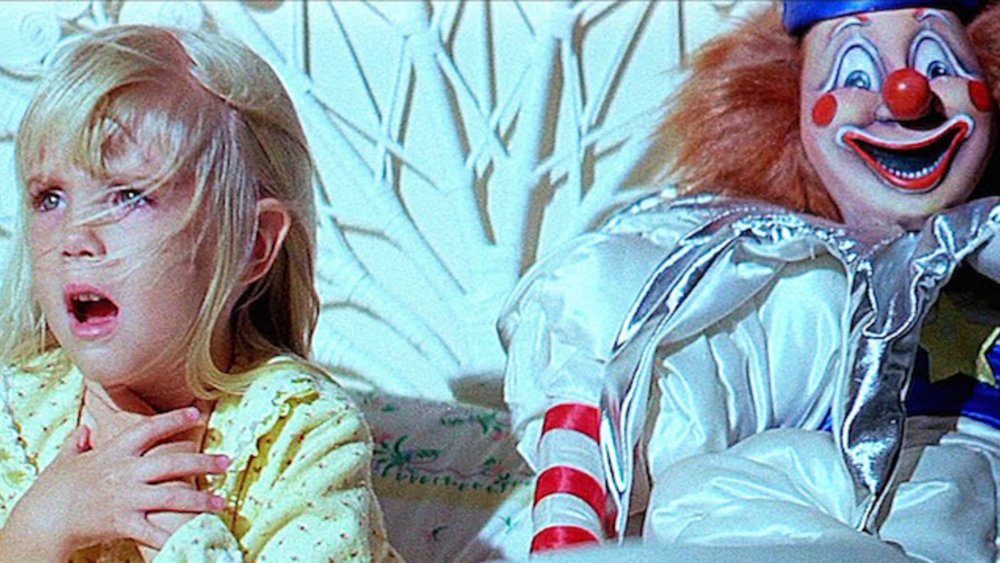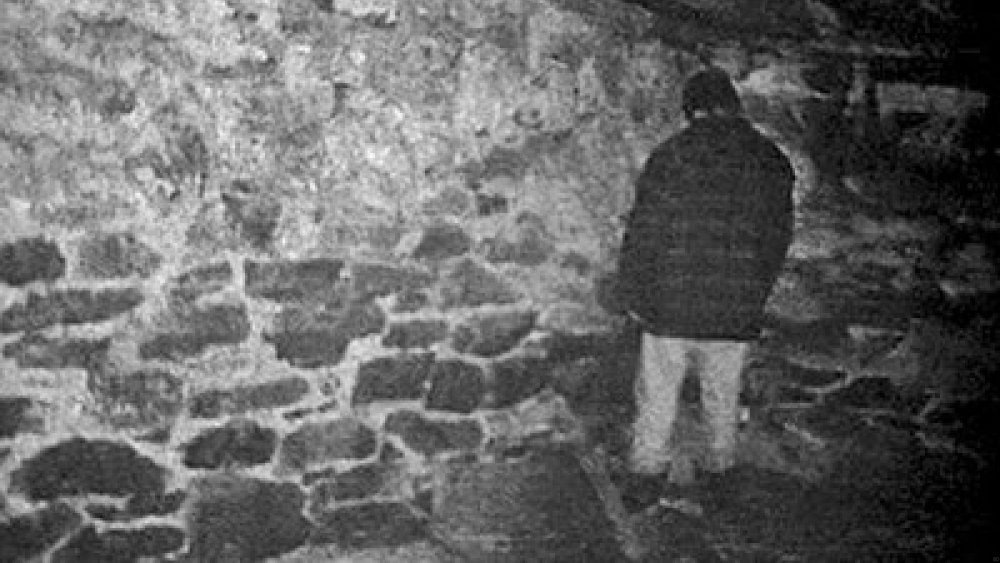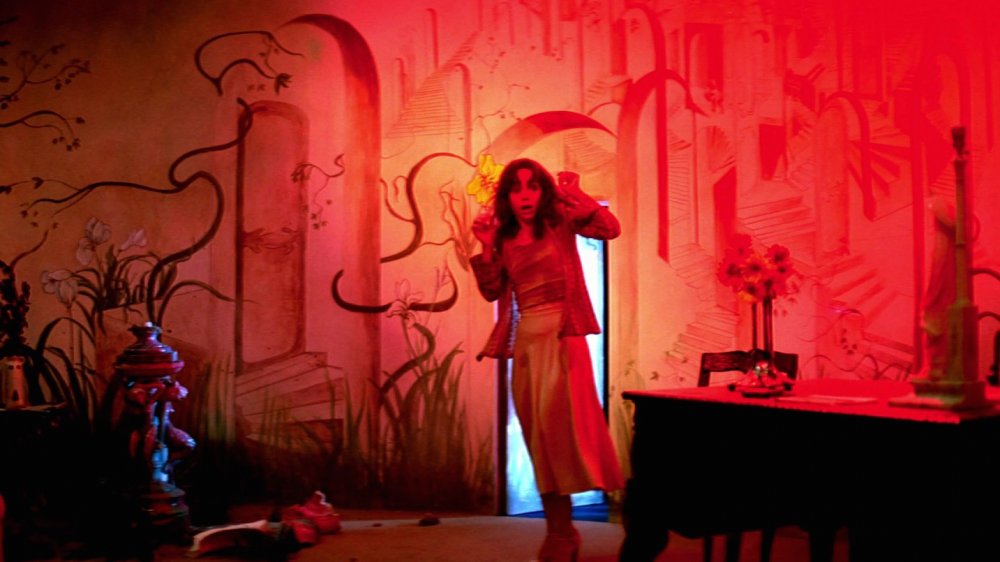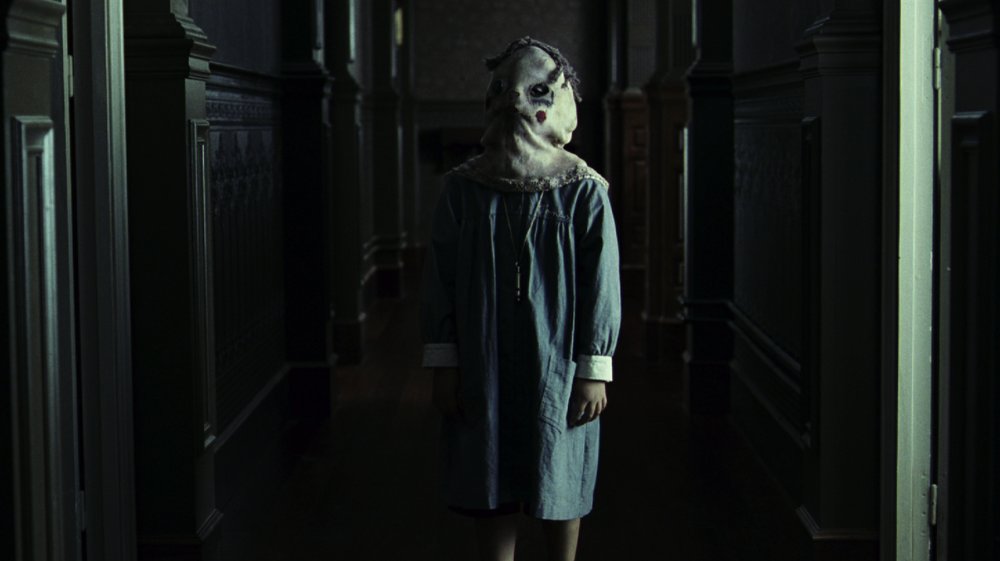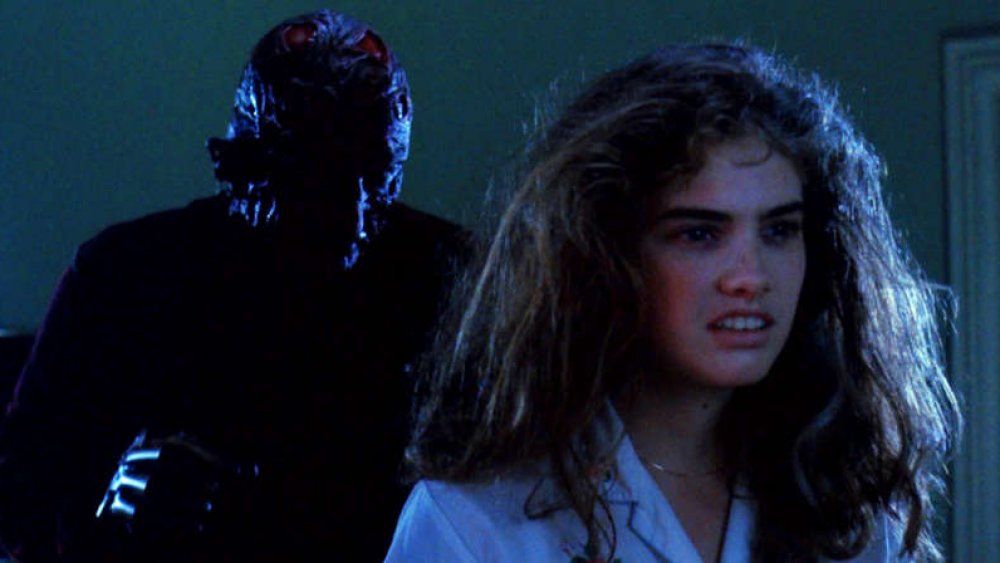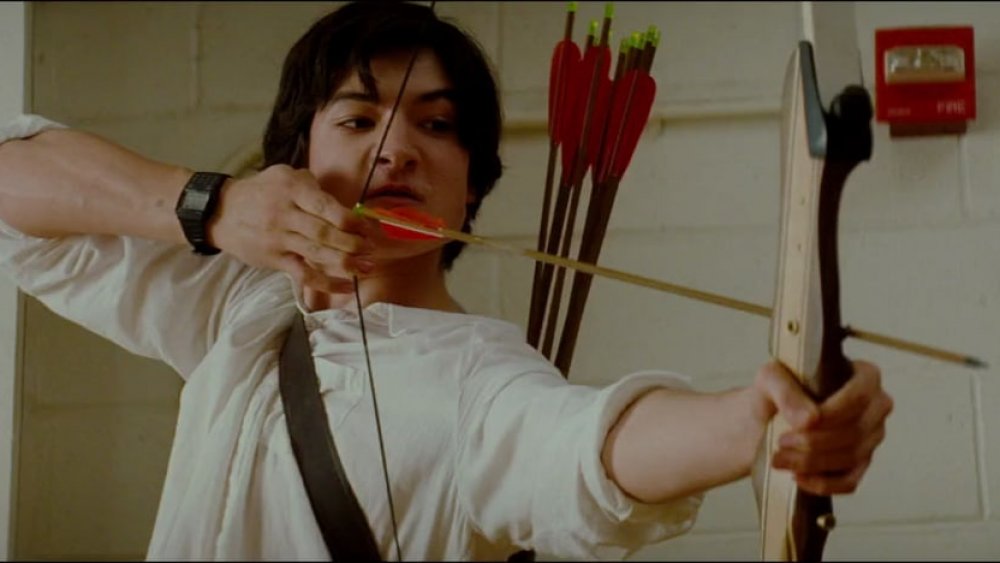These Are The Scariest Movies Of All Time
It's a horror movie's job to scare the heck out of audiences. But sometimes, a horror movie goes so above and beyond the usual bounds of fear that it makes its way into a truly rarefied category: The scariest movies of all time. These movies put characters through the worst day of their lives – even if they survive, they are irrevocably changed. What menaces these heroes? Pretty much everything. Home invasions, serial killers, unfortunate accidents, and paranormal terror can all be found in these movies. Monsters range from shape-shifting aliens to demons literally hell-bent on possession. The environment itself can even be the antagonist: Caves, swamps, and desolate ghost towns have proven themselves to be sites of terror and torment. What unites these movies is their mastery of fear — and we're here to celebrate it. These are the scariest movies of all time.
Martyrs
Pascal Laugier's 2008 film Martyrs is a multilayered tale of torture, revenge, and terror. If you can get through this brutal example of New French Extremity, you'll never be able to forget it. The film follows Lucie, a woman who suffered devastating childhood abuse, and her best friend Anna. Having spent years tormented by memories, Lucie slaughters the family she believes tortured her as a child. You might assume this movie is a descent into Lucie's psychosis, but it turns out to be an entirely different can of worms when Lucie commits suicide and Anna takes the reigns of the story.
Martyrs is a bleak look at the way childhood trauma can destroy a person, as well as an exploration of the way society exploits young women. The film's graphic violence is terrifying, but it's Martyrs' complete absence of hope that makes it one of the scariest movies of all time.
Get Out
Jordan Peele's Get Out is an unflinching look at race in America. Photographer Chris and his girlfriend Rose have traveled to her family's estate in upstate New York. Chris thinks he is Rose's first Black boyfriend, but he's dreadfully wrong: The Armitage family are actually serial killers who transplant the brains of aging white folks into the bodies of the young, healthy Black people they kidnap.
The Armitages' perfect country home, their mannerly demeanor, and even their liberal politics are the cornerstone of Peele's scathing critique of whiteness in America. But even after Chris manages to escape their clutches, he is confronted with the flashing lights of a police car. Audiences hold their breath, wondering if Chris, who has just survived monsters, will be murdered by the police. This haunting end makes Get Out one of the scariest movies ever, and a devastating exploration of systemic bigotry.
The Descent
Neil Marshall's claustrophobic masterpiece The Descent is terrifying in premise alone: A group of besties get trapped in an undiscovered cave system with no apparent way out. That alone warrants inclusion on a list of the scariest movies of all time. But the horror increases exponentially when the women discover they're trapped with a horde of cannibalistic monsters who have evolved to live underground.
Our heroines are forced to become their most primal selves in order to survive. The version of the movie that aired in the UK has a far bleaker ending than the one eventually released in America: The women never actually make it out of the cave. Sarah hallucinates escaping, only for the closing shot to reveal just how deep down she is, and how slim her chances of escape truly are ... especially given the monsters closing in on her. Chilling.
Alien
"In space no one can hear you scream," reads the tagline for Ridley Scott's nightmarish Alien, which certainly delivers on that creepy premise. The crew of the Nostromo find out way too late that a distress signal from an unknown planet is actually a warning to stay away. By that point, a crew member has already been attacked by a mysterious alien creature, whose implanted egg bursts from him in a famously gruesome scene. Worse, the crew overrides the acting captain and breaks quarantine procedures, which leads to the alien creature wreaking havoc on the ship.
Visually masterminded by H.R. Giger, Alien is simultaneously terrifying and gorgeous. The "chestburster" scene is as harrowing now as it was decades ago, while Ripley's confrontation with the creature is equal parts exhilarating and horrifying. Alien is suspenseful, strange, and exciting as all get-out.
The Conjuring
As The Conjuring has spawned an entire Conjuring Universe of movies, it's easy to forget how bone-chillingly scary the first installment is. Introducing paranormal investigators Ed and Lorraine Warren as they investigate a possible poltergeist at a Rhode Island home, The Conjuring masterfully balances short-term scares with slow-burn narrative energy. Seriously, only a movie at the top of its game could weave together possessed dolls, secret passages, and centuries-old curses into a coherently terrifying ending.
Director James Wan draws some truly chilling performances from the film's child actors, who do so well, they improve everything around them. You'd think kids in peril might be a well-worn horror trope, but The Conjuring reminds you why it's a cliche in the first place: Kids make horror visceral. The devil-worshiping, child-murdering ghost-witch working her dark magic from well beyond the grave is all the more terrifying for menacing these particular kids. The Conjuring is classic horror done right.
The Thing
It's one thing to be isolated in Antarctica during a blizzard. It's another thing entirely to be isolated along with a shape-shifting alien entity that you and your crew accidentally dig up. It's worse still when said alien turns out to be capable of mimicking humans perfectly, making it impossible to know who to trust. Glimpsed through the eyes of helicopter pilot MacReady as he and his crew try to contain the alien being, John Carpenter's The Thing is a work of uniquely potent psychological horror.
The creature itself is a horrifying amalgam of all kinds of creepiness, from arachnids to disembodied human parts. But what might be scarier than the monster is the way the humans turn on each other in an instant. Their senses of trust and community are casualties of the monster right alongside their lives. The Thing's ambiguous ending only adds to the terror inherent in this story.
Halloween
Laurie Strode is a typical teenager who spends her time babysitting when she's not in school. Then murderous Michael Myers breaks out of his institution and burns Laurie's normal life to the ground. John Carpenter's Halloween provides a master class in suspense as Myers weaves his way in and out of Laurie's orbit, slowly shredding her sanity. When the horrifying and prolonged showdown that ends the film arrives, it's with a sickening inevitability. Yet still, it somehow manages to thrill and surprise, even decades after the film's release.
Michael Myers is unique among slasher villains in that he remains inexplicable. We really never gain any insight into why he is the way he is. Even the sequel, released in 2018, offers little in the way of understanding. This makes Myers uniquely frightening: There is no secret memory, explanation, or phrase that might disable him, or even just render him more comprehensible. He is terror personified, and that makes for a classic movie.
The Shining
Stanley Kubrick's cinematic adaptation of Stephen King's novel, The Shining, might not be the most faithful adaptation of the book, but it is one of the scariest films of all time. Set in the remote Overlook Hotel during the height of a Rocky Mountains winter, the isolation of the setting is terrifying on its own. But when you throw malignant ghosts, alcoholism, and the madness of writer's block into the mix, well ... the stakes don't get much higher than that. The Shining is a whirl of terrifying imagery, strange behavior, and family drama that builds to one of the most unforgettable climaxes in horror history.
The fact that it's unclear whether the ghosts are real or figments of the Torrance family's imagination adds to the unsettling nature of the movie. Its chilling ending (pun intended) is shocking, but also deeply ambiguous. Therein lies the film's greatest strength — and its greatest scare.
The Strangers
Horror movies about home invasion are particularly scary: They very literally bring the horror home. The Strangers is one of the scariest of them all, thanks to its understated production values, realistic tone, and stupendous performances. Liv Tyler and Scott Speedman play a couple on the rocks who are terrorized by a trio of masked intruders who break into their vacation home. Much scarier than what the masked killers do is why they say they are doing it: "Because you were home." That shudder-inducing line is one of the scariest motivations ever uttered on screen. The Strangers' bleak ending suggests that the trio have done this many times before, and will do it again until someone stops them. They're more forces of nature than people, every element of humanity concealed behind their dissonant masks. They can't be stopped, understood, or reasoned with: They live to torment, end of story.
Candyman
After being tortured, mutilated, and lynched for the crime of falling in love with a white woman, Daniel Robitaille returns as the ghostly killer Candyman, whose terrifying presence is invoked by saying his name five times while looking in a mirror. His signature phrase, "Be my victim," is accompanied by swarms of bees that erupt from his body. He has a hook jammed into the raw flesh of his wrist. He is grisly, unique, and altogether unforgettable.
Daniel Robitaille's tragic backstory remains a relevant indictment of American racism, while Tony Todd's commanding performance as the titular killer forms the rock-solid foundation the rest of the movie builds upon. Candyman is one of the most complicated slasher movies around, weaving a web of violence, history, sorrow, and fruitless rage. It is a pained, frustrated howl of a movie, as cathartic and sorrowful as it is genuinely entertaining. Now that's horror.
The Babadook
In Jennifer Kent's The Babadook, the monster seems to be a figure from a mysterious children's book found by Samuel, a young boy being brought up by his widowed mother, Amelia. But the actual villain of The Babadook is grief. Amelia and Samuel's pain at the tragic and unexpected loss of their husband and father has curdled into something utterly devastating — something they need to face head-on, before it destroys them both.
Amelia and Samuel are driven to the edge of madness by their bereavement, to the point that Amelia attempts to murder her own son. When their salvation arrives, it's surprisingly gentle ... and all the more heart-wrenching for it. From its story to its performances, The Babadook is as powerful as it is scary. You might very well go to bed that night, warmed by the hopeful ending ... until you realize you have to turn out the lights.
Seven
David Fincher's neo-noir crime horror Seven may have been memed to death — "What's in the box?!" — but that does not make the film even a little less scary. Following Detectives Mills and Somerset during Somerset's last week of work, the partners investigate a serial killer who is using the seven deadly sins as his guidebook. Fincher's chilly aesthetic understates the horror of each murder, which actually makes them scarier: A world in which these grotesque deaths are treated as normal is a frightening prospect.
Most of the violence takes place off screen, which is both blessing and curse — this is a movie that wants your imagination to go wild with the details it provides. Seven's ending is also one of the bleakest of all time, and one of the most unique: In being caught, the killer wins. The villain's plan is a masterstroke of horror — as is the movie that features him.
Contagion
Even before pandemic was the order of the day, Steven Soderbergh's Contagion was one of the scariest movies of all time. Told in Soderbergh's classic ensemble style, the movie follows a number of key players as a virus spreads across the globe. What started its rampage? A bit of infected pork, prepared by a chef who didn't wash his hands. Cue global collapse.
Scenes of overrun hospitals and mass graves fill Contagion's runtime. It's a viscerally painful film to watch — the senselessness of it is overwhelming. A minor bit of human inaction is to blame here, followed by waves of selfishness and anxiety. There is no monster to unmask, no killer to take down. There's just a mindless virus, and a whole lot of humans indulging their worst instincts. It's a terrifying story, and one that lingers long after the credits roll.
The Ring/Ringu
Both the original Japanese horror film, Ring, and its American remake, The Ring, are top contenders for scariest movie of all time. While Ring may be more understated when it comes to imagery and production, The Ring doesn't ever feel over the top. They're two variations on a great story — both of which will scare you beyond your limits.
Both films follow a haunted video tape that kills its viewers in seven days if they don't make a copy of the tape and share it with another person. If that's not a spooky enough premise for you, the story of the demonic ghost girl who haunts the tape is the stuff of nightmares all by itself. The moment that Samara crawls through the television has become iconic for good reason: It's a shocking defiance of the natural order of things. And isn't that horror in a nutshell?
An American Werewolf in London
American tourists Jack and David are given two pieces of advice by Yorkshire locals: Stay off the moors and stay on the road. But the two don't follow these basic instructions, and so Jack gets mauled to death by a mysterious creature and David gets badly scratched. David begins to suspect something is amiss as he starts having horrific nightmares ... and then he wakes up in the wolf enclosure of the London Zoo.
David's first transformation into a werewolf remains one of the most painful and terrifying scenes in movie history. Jack's appearances as an ever-deteriorating corpse are just as horrifying — to say nothing of David's murders of multiple innocent Brits. Add in some truly astonishing special effects work and brilliant moments of black humor, and you've got the scariest backpacking story ever told.
The Omen
The story of a wealthy and well-connected family who begin to suspect their son is the Antichrist, The Omen features one of the scariest children ever put to screen. Damien Thorn is a strange boy to whom strange things happen. A mysterious Rottweiler shows up to protect him, for example, as well as a creepy nanny who takes her job as Damien's caretaker far too seriously. The plot thickens dramatically when Damien's father Robert discovers their real child was murdered and switched with Damien, who was birthed by an actual jackal. The Omen's haunting film score, tremendous performances, and strong script add up to a harrowing journey into evil — one that still manages to shock. Even today, the moment Robert uncovers the graves of his son and Damien's canine mother remains profoundly unsettling.
Open Water
Jaws may be a classic, but it has nothing on the oceanic terror of Chris Kentis' Open Water. Hard-working couple Daniel and Susan go on a tropical vacation to reconnect, but end up getting left behind in the ocean after their scuba leader miscounts the folks on board the ship. The couple spends days out in the open water. It's not long before the sharks begin circling ... or before the two feel their strength begin to wane.
If this premise doesn't scare the wetsuit off you on its own, consider this: It's based on a true story. Watching Daniel and Susan struggle to survive as the sharks get bolder and they grow more dehydrated is terrifying enough on its own, but to know that two people actually went through this? That's another level of horror entirely. The ending is as chilling and hopeless as it is quiet, and that makes it unforgettable.
Gerald's Game
Mike Flanagan's adaptation of Gerald's Game, once considered Stephen King's most unfilmable novel, has multiple levels of fear going on at once. Jessie Burlingame's husband, Gerald, dies atop her in a remote cabin, leaving her handcuffed to the bed. The front door is open, allowing a dog to get in and begin eating Gerald's corpse. Things go from bad to worse as Jessie relives childhood sexual abuse and begins to suffer the effects of dehydration. Then, a monstrous man begins visiting her at night ... who turns out not to be a hallucination, as Jessie wills herself to believe.
Gerald's Game hits hard and fast with moments of emotional agony, shocking gore, and sickening cruelty. In the hands of its capable director, it all works together to create a truly disturbing work of horror. Jessie survives her ordeal, but no viewer will ever forget how.
The Sixth Sense
We all know the twist in M. Night Shyamalan's The Sixth Sense by now, yet it continues to be one of the scariest movies of all time. Young Cole is brought to child psychologist Malcolm Crowe for help in handling what appear to be delusions: Cole claims he sees and hears dead people. Nobody believes him at first, not even Crowe. But as time goes on, the truth of Cole's gift becomes clear ... and the truth about Crowe.
The Sixth Sense's ominous tone, strategically placed jump scares, and clever staging keep it tense, while its strong performances make it a story worth watching again and again. Though it's often considered a thriller, rather than a horror movie, it doesn't skimp on darkness: One subplot memorably features a stepmother poisoning her new children for attention. This is a story about the murky complexities of the human heart, and the way they linger ... even after death.
28 Days Later
Danny Boyle's kinetic 28 Days Later was a total genre game-changer. While technically the infected are under the influence of a rabies-like virus and not actually undead, their erratic behavior and bloodlust make them some of the scariest zombies put to screen. Yet even their monstrousness is dwarfed by humanity's: When our heroes find a gaggle of soldiers who have repurposed an abandoned manor into a military base, they learn that the women of their group will be forced into sexual slavery. The idea that humans could be as dangerous as a zombie virus is what makes 28 Days Later a truly disturbing work of horror and an unforgettable zombie film. The undead, in this case, aren't the only threat ... and far from the most sinister.
The Exorcist
Like home invasion stories, tales of demonic possession are a uniquely terrifying sub-genre of horror: Both explore the breach of a person's physical and spiritual autonomy by malignant outside forces. No film encapsulates this horror more potently than William Friedkin's The Exorcist. Young Regan's possession by the demon Pazuzu is viscerally horrible: The entity absolutely trashes her body with sadistic glee. The exorcism itself is equally grotesque — possession is a bloody, brutal business in this film, and all the more frightening for it. But The Exorcist is also a terrifying look into medicine's long history of disbelieving women and children. Ellen Burstyn's performance as Regan's struggling single mom, Chris, grounds this film in firm reality in this regard. She is helpless to save her child, even as said child begins lobbing wardrobes around her room with her mind. The horror might be fantastical, but the experience is all too real.
The Last House on the Left
Wes Craven's The Last House on the Left is an absolutely brutal movie. After best friends Mari and Phyllis are kidnapped, sexually assaulted, and murdered by a group of escaped psychopaths, the killers decide to torment Mari's family. But the tables quickly turn once said family realizes that these people killed their daughter. They enact swift, gruesome, and totally unforgettable revenge.
Estelle and John Collingwood exemplify good people gone bad, thanks to extenuating circumstances. Watching John take a chainsaw to the final murderer in plain sight of the sheriff is a truly striking horror movie moment for this reason: It's a powerful indictment of the evils regular folks might commit if pushed too far. The Last House on the Left puts the viewer in a uniquely uncomfortable position, as a result — and a uniquely powerful one. At what point, the movie asks, does bloody catharsis become outright horror?
Poltergeist
Featuring ghostly kidnappers, demonic clown dolls, a bone-filled swimming pool, and sentient trees, Poltergeist set the bar high for stories of supernatural horror. The Freeling family is perfectly normal and happily ensconced within their home in a planned California community. Everything falls apart when their youngest child, Carol Anne, begins acting strangely. When the girl is pulled through a mysterious portal, the situation only gets worse. The entire community, it turns out, is built on a graveyard: Developers only moved the headstones. Now, the dead are out to assert themselves.
As if that's not bad enough, the film itself was plagued with tragedy, both during filming and after. Plus, remember that horrific pool scene? Those are actual human bones, not props. Poltergeist's position as one of the scariest movies of all time will always be secure, thanks to its hair-raising storyline and real-world spook factor.
The Blair Witch Project
When The Blair Witch Project first came out, the film was marketed as a true story, which made watching it a truly harrowing experience. Today, most viewers know it's not actually real — but the creepiness persists regardless. Watching Heather, Mike, and Josh lose themselves in the Maryland woods, on the hunt for the Blair Witch, remains a long and terrifying journey into dread. As the hunters become the hunted, Heather reflects on the various mistakes they made which got them into this awful predicament. This scene has been parodied to death, and yet it retains its power: Heather's desperation is undeniable, making Blair Witch equal parts sad and scary. The ending never fails to shock, as it leaves so much to the imagination. We never fully learn what actually happens to the three documentarians, but we can certainly imagine — and that makes it worse.
Suspiria
Dario Argento's moody classic Suspiria is as much an arthouse movie as it is a gory descent into the supernatural. Suzy Bannion is new to her fancy German dance school, but it's not long before she notices the school has a body count. As she uncovers the demonic coven of witches at the heart of her academy, things go from bad to worse in increasingly baroque ways. Scored by celebrated prog rock band Goblin, the creepy music that wallpapers Suspiria adds to Suzy's mounting dread. Grotesque imagery abounds: Once you see a woman trapped in a huge ball of barbed wire, you'll not soon forget it. Add in Argento's close-up camera work and the film's vibrant use of color, and you've got a symphony of horror. Sight and sound harmonize to take the viewer to new heights of fear in Suspiria – one marvels at its beauty, even at its most shocking.
The Orphanage
When protagonist Laura returns to the orphanage where she was raised, looking to turn it into a center for disabled children, she brings her husband Carlos and son Simón along with her. But when Simón makes an imaginary friend who wears a sack over his head and who claims to be the ghost of a former resident, the entire history of the orphanage begins revealing itself. Soon after, Simón goes missing. Laura must dive into the disturbing history of her home to find out what tragedy befell her son, but the truth is not what she — or the audience — could have ever anticipated.
The reveal at the end of The Orphanage is as heartbreaking as it is petrifying. This is a movie that terrifies, yet also a movie that solemnly explores the lasting scars of childhood. The Orphanage's bleak ending does come with a ray of hope, at least — even if it is in the afterlife.
The Vanishing
After a serial killer and psychopath kidnaps a young woman named Saskia from a rest area, her boyfriend Rex becomes obsessed with finding her. When her murderer, Raymond, reaches out to Rex, he can't help but take the bait. Raymond tells him he will reveal where Saskia is ... but only if Rex goes through what she went through first. Rex agrees, only to end up reliving Saskia's horrifying death. The ending of The Vanishing is unimaginably horrific and bleak, with an absolute lack of hope or accountability. This is the type of movie that haunts you for the rest of your life. Yet it is also a remarkably understated work of horror, and a quiet and astute exploration of sociopathy. This low-key approach underlines Saskia and Rex's ordeal, making it an unforgettably blood-curdling experience.
A Nightmare on Elm Street
Being stalked by a serial killer is bad enough, but being stalked by one who murders people through their dreams is next-level scary. So proceeds Wes Craven's A Nightmare on Elm Street. Freddy Krueger was once a neighborhood pedophile who was killed by a group of locals when his activities came to light. After they burned him up, they vowed never to speak of him again.
Years go by, in which Krueger's spirit devises the ultimate revenge: He will murder the children of the people who murdered him. The use of dreams makes Nightmare a movie still capable of invoking actual nightmares: Their lack of logic throws all the normal rules of horror out the window. What do you do when the only way to avoid your monster — not sleeping — is physically impossible? Freddy Krueger is a movie monster unlike any other, and that's what makes this film a spine-tingling classic.
We Need to Talk About Kevin
We Need To Talk About Kevin explores past and present to harrowing effect. Eva Khatchadourian's son Kevin murdered his classmates, his father, and his little sister with a bow and arrow. She is desperate to understand how this happened — and what her part in it was. Could Kevin detect Eva's ambivalence toward motherhood? Did Kevin's kind father ignore certain warning signs? Was Kevin somehow born evil?
The violence in this terrifying story is understated, which makes it all the more shocking. Tilda Swinton as Eva and Ezra Miller as Kevin both give tour-de-force performances that break your heart as they scare the living daylights out of you. This is a movie that untangles its story like an old knot, thread by thread ... only to find that there might not be a beginning or end to discover. And that's the scariest thing of all.
